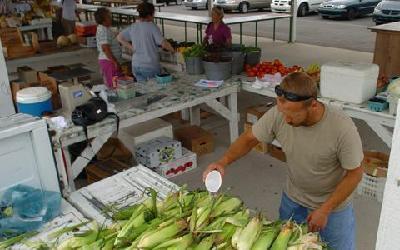
This is the VOA Special English Agriculture Report.
Last week we discussed how to grow vegetables in partial sun. This week we learn how to protect vegetables from too much sun.
Curtis Swift is an extension agent at Colorado State University. He says shading plants from intense sunlight in hot weather can increase production. Plants can suffer damage when their temperature rises above 32 degrees Celsius.
CURTIS SWIFT: "Tomatoes, peppers, eggplants, and okra and other members of that family drop flower buds and young fruit when the plant temperatures exceed 32 degrees C."
Plants can get sunburn. Yellow spots may appear on their leaves and fruit. These areas can become thin and white as plant tissue is affected.
Curtis Swift says shade can help correct these problems.
CURTIS SWIFT: "What it does is, it actually allows the plant to give off adequate water, which cools the tissue."
He suggests shading plants with bed sheets, shade cloth or brush -- in other words, sticks and branches. Cut them about a meter long and stand them in the ground on the south and west sides of plants.
CURTIS SWIFT: "Anything you can put over the plant. A lot of people can cut brush at the edge of the field and stick that into the soil on the south and west side of the plant and provide some shade."
Curtis Swift says if you use cloth sheeting, suspend it at least five centimeters above the plants. That way there is enough space for bees to fly around. Be careful not to cover plants too closely. It could trap heat and defeat the purpose of shading.
People can also buy canopies to shelter their plants. Some canopies have narrow strips of metal or wood to provide either sunlight or shade, depending on the position of the sun.
Curtis Swift says shading works with field crops as well as vine crops like squash. People sometimes plant shrubs or trees to shade their vegetables. But he says tree roots compete with the vegetable roots. The veggies may not get enough nutrients and water.
And that's the VOA Special English Agriculture Report, written by Jerilyn Watson. Here are a few of your comments about last week's report on shade growing. Ko from South Korea wrote: I can't imagine plants in the shade for most of day without sunshine! That's a really creative idea.
Andy in Chile wrote: This is an interesting article. But you forget that the shadow allows the growth of the fungi. And Slava in Croatia recalled: Once I grew small tomatoes on a balcony under a roof. Sun shone there only in the afternoon. In October the plants had only a few green tomatoes. I took them inside behind the window and they had ripe fruits on Christmas and the entire winter.
If you missed our report, you can find it at voaspecialenglish.com. I'm Bob Doughty.
okra: long mucilaginous green pods 秋葵莢
vine crops: 藤類作物
Gardening: vegetables made in the shade
Art of darkness: growing vegetables in shade
Inventor of weed eater started a revolution
Grow it yourself: onions are nothing to cry about
(來源:VOA 編輯:實習(xí)生史莉萍)
